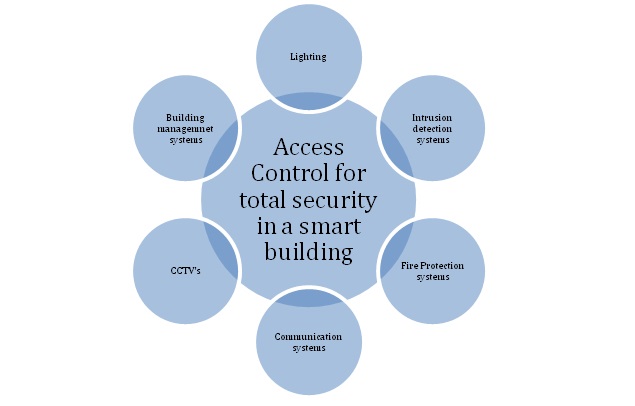by Aanchal Singh, Research Analyst, Building Management Technologies — November 2015 — The smart building systems market showed a positive compounded annual growth rate of 12% in 2014. Even though the general economic outlook of the global economy depicts modest to steady growth, the intelligent building market is an impressively growing industry segment. Facility managers have deployed smart technologies in intelligent buildings to reduce energy consumption, lower operational costs, and provide an attractive return on investment.
In the past few years, existing facilities have evolved and are going above and beyond installing one central automation system to control buildings’ operations. Increased proliferation of advanced technologies in smart building has created its own set of issues; hence, the building automation market has reasonable security concerns for existing facilities. Security issues and threats could be in various forms. In order to secure credential and identity management, access controls are the most widely used application across most facilities and commercial spaces. Frost and Sullivan indicates that globally, access control accounts for 43.6% of the total security market. The primary driver for access control at present is the need to safeguard people, and to protect physical and intellectual property from external as well as internal threats. Therefore, as the notion of intelligent building has evolved, the owners of existing buildings are moving toward a more integrated approach, which extends to issues such as security, data analysis, communication, and robust monitoring and control.
Initially, security and building automation systems where developed separately, but as spaces become smarter, facility managers are deploying and unifying access control systems with different building management technologies that can address the entire building’s vulnerabilities—not just a limited portion of the entire occupant’s space. In order to construct overall secured facilities, the facility managers will require a comprehensive access control system along with IT security programs attached to building automation systems. Thus, access control systems become an imperative part of a facility that must restrict access and keep building occupants and confidential data safe.
Frost & Sullivan indicates that the rise in innovative and smart technologies has created a growing need for both physical- and network-based access controls to protect data. The infrastructure of an existing intelligent facility is such that it can easily be a host of elements, such as cloud, remote access, and data sharing and analysis, and these become crucial in reaping the benefits of a connected and converged space. With the presence of active IT-aided infrastructure and smart controls and sensors, the method of integration of access control with other elements in a facility can create real-time transmission of data for the purpose of predictive analytics and diagnostics to facilitate better management and optimization of any given facility. Additionally, the method also enables the converged access control technologies to create a well-defined security management that provides control and awareness of assets in and around any space or any restricted areas.
Physical access controls, such as video surveillance and intrusion detection systems, is a bigger segment of the access control market in North America. The access control industry is experiencing a transition from traditional, proprietary-based, standalone access control architecture toward more adaptable solutions that require an IP-based network. This is considered a primary convergence trend for existing facilities. Hence, facility owners are increasingly adopting the innovative solutions linked with the integration of physical access control, along with logical access control systems. The convergence with logical security has become much simpler to implement, while providing better flexibility to the facility owners. By merging these technologies, facilities can better authenticate and authorize access for any entities entering the facilities, either physically or through the network. This can help facilities manage multiple systems that are easy to use, and can ensure security and privacy.

Diagram: Integration of access control for comprehensive security in an intelligent building
Source: Frost &Sullivan
Over the past few decades, an additional transitional trend in the access control market within the physical access control is the rapid evolvement and transition of the security technology from mechanical locks to biometric access control systems. This biometrics authenticity model is a constantly evolving digital trend in intelligent facilities. Facility owners realize the benefits of Internet of Things (IoT), which can seamlessly enable the integration of biometric technology with cloud IT services. The trend for adoption of these integrated systems operationally and systematically will maximize facility owners’ investments. According to Frost & Sullivan, the biometrics market is depicting a growth rate of 21.9% growth over 2014. Hence, the biometric market is growing at a much faster rate and its integration with the physical access control technologies will encourage the facility owners to recognize and capture any future thefts and security issues within the facilities.
Along with the benefits, the facility owners also face a few challenges. Facility managers often come across core complexities in existing or older buildings that have legacy BAS systems. These systems are more susceptible to security breaches and attacks. Yet, most of the time, facilities managers are often thinking about security concerns in newer buildings; hence, it is essential that older database systems and Web browsers in legacy building have the infrastructural capacity to make a smooth technological shift to protect both tangible and intellectual assets from theft or being compromised. These challenges can be further exacerbated with the changing business environment needs, each depicting different levels of access. Undoubtedly, this can pose a challenge for facilities management teams to enforce strict access criteria at many levels. But this trend is expected to change, as many key industry participants are offering innovative access control solutions.
Sources:
Automated Buildings.com
Frost and Sullivan Study- “Global Outlook of Biometric Market”
Frost and Sullivan Study- “The Smart building Systems Market in North America”